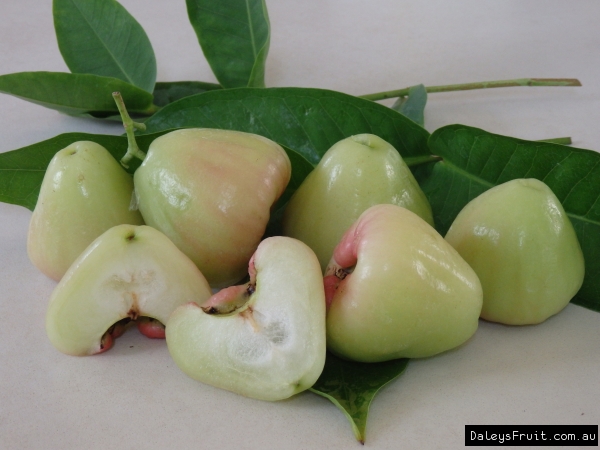Wax Jambu - White
Syzygium samarangense$54.00 ($39.00-$79.00 choose a size)
When will it be in Stock?
We previously had the most to buy in Oct and May. With limited quantities for sale in other months. They are unlikely to be available in Jun and Jul. Remember to click above to get notified when it is available once more.
Specifications of Wax Jambu - White
Preferred Climate Tropical, SubtropicalLearn About Climate Zones
Grown From CuttingLearn About Propagation Methods
Max Height (when in the ground with good conditions) 2-5m
Plants required to Pollinate 1 (Self Pollinating)Learn about Pollination
Can it Handle Frosts? Likes Temps above 5deg
Amount of leaves in Winter? All Leaves (Evergreen)
Quarantine Restrictions to these Areas SA, WA
Water Requirements Moderate Watering
Is it a Dwarf Fruit Tree? Can be pruned to 2m
Time to Fruit/Flower/Harvest 2-3 Years
Sun or Shade Full (Sun:80%-100%)
Preferred Soil Type Good Drainage
Soil pH Neutral (6.6-7.3pH)
Fruiting/Harvest Months January, February, March
Fertiliser All Purpose, Compost, Seaweed, PotAsh, Sulphur
Plant Width 2-4m
Growth Rate Medium
Create a Filter to find similar plants
Customers also bought
These plants are often purchased together. Also check plant information for suitability in your orchard.
Wax Jambu - Red
$34.00 ($34.00-$79.00 choose a size)
Achacha - Grafted
$99.00
Dwarf Mulberry - Red Shahtoot
$49.00 ($19.75-$99.00 choose a size)
Loquat - Nagasakiwase
$44.00 ($44.00-$79.00 choose a size)
Carambola Starfruit - Daleys Sweet Gold
$99.00
Canistel Aurea
$79.00
Customer Tips & Reviews Wax Jambu - White
COBURG, VIC, Australia
Growing fairly well, after first losing all it's leaves. It does much better if protected from wind.Water weekly-fortnightly in Spring and Summer. Next to no water in winter to keep it dormant. In winter, it is protected on the verandah.However...
Bardon, Qld, Australia
This plant is barely hanging on but looks awful thanks to the possum nibbling of any new growth. Although it is growing rapidly as the possum's new favourite I don't think it will last.
Wakeley, NSW, Australia
I tried this white variety while overseas and it was delicious. According to the label it's very frost sensitive so in winter I moved it under shelter at night and move it back out during the day. It's currently in a pot with heaps of flower blooms but...





































